Business Sustainability: Systems Thinking and Tourism Challenges
VerifiedAdded on 2023/04/21
|10
|2727
|250
Essay
AI Summary
This research essay investigates the critical role of systems thinking in addressing sustainability challenges within the global tourism industry, focusing on the 'tourism trap' phenomenon. The essay argues that sustainable tourism requires a balanced approach between resource utilization and conservation, achieved through long-term planning and continuous monitoring. It highlights the economic, social, and environmental dimensions of sustainable development, emphasizing the importance of stakeholder engagement, including local communities, tourists, and government entities. The essay identifies key sustainability challenges imposed by the tourism trap, such as climate change, unbalanced resource consumption, destination mismanagement, and ineffective cross-cultural management. It proposes solutions centered on tourism governance, investment, capacity building, social inclusion, and environmental sustainability, all underpinned by systems thinking. The essay concludes by recommending that tourism operators prioritize environmental and social commitment over short-term profit, promoting a holistic approach to sustainable tourism development. Desklib offers more resources for students.
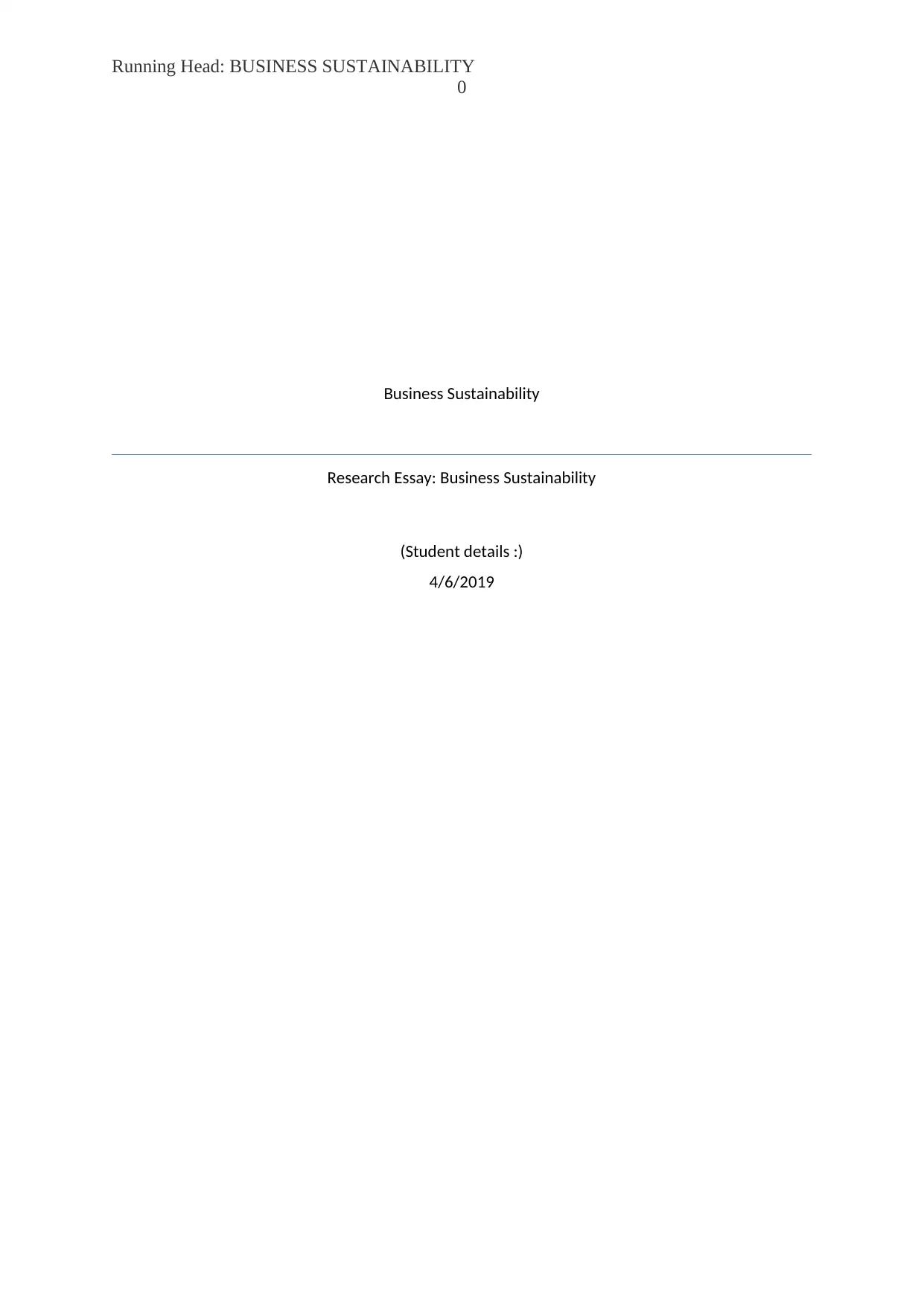
Running Head: BUSINESS SUSTAINABILITY
0
Business Sustainability
Research Essay: Business Sustainability
(Student details :)
4/6/2019
0
Business Sustainability
Research Essay: Business Sustainability
(Student details :)
4/6/2019
Paraphrase This Document
Need a fresh take? Get an instant paraphrase of this document with our AI Paraphraser

Business Sustainability
1
Contents
Introduction................................................................................................................................2
Business Sustainability: The Tourism Trap...............................................................................2
Future recommendations............................................................................................................7
Conclusion..................................................................................................................................7
References..................................................................................................................................8
1
Contents
Introduction................................................................................................................................2
Business Sustainability: The Tourism Trap...............................................................................2
Future recommendations............................................................................................................7
Conclusion..................................................................................................................................7
References..................................................................................................................................8
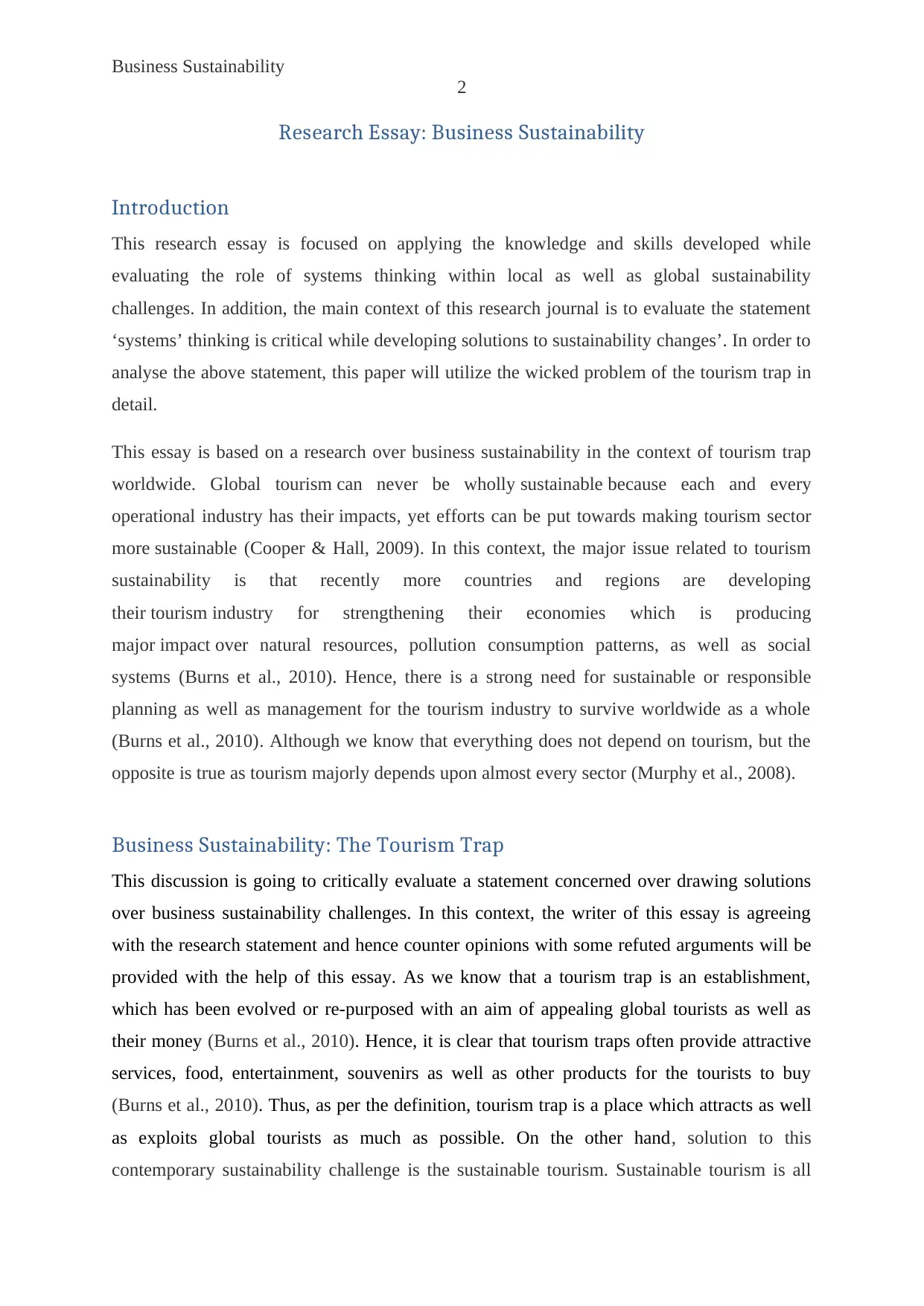
Business Sustainability
2
Research Essay: Business Sustainability
Introduction
This research essay is focused on applying the knowledge and skills developed while
evaluating the role of systems thinking within local as well as global sustainability
challenges. In addition, the main context of this research journal is to evaluate the statement
‘systems’ thinking is critical while developing solutions to sustainability changes’. In order to
analyse the above statement, this paper will utilize the wicked problem of the tourism trap in
detail.
This essay is based on a research over business sustainability in the context of tourism trap
worldwide. Global tourism can never be wholly sustainable because each and every
operational industry has their impacts, yet efforts can be put towards making tourism sector
more sustainable (Cooper & Hall, 2009). In this context, the major issue related to tourism
sustainability is that recently more countries and regions are developing
their tourism industry for strengthening their economies which is producing
major impact over natural resources, pollution consumption patterns, as well as social
systems (Burns et al., 2010). Hence, there is a strong need for sustainable or responsible
planning as well as management for the tourism industry to survive worldwide as a whole
(Burns et al., 2010). Although we know that everything does not depend on tourism, but the
opposite is true as tourism majorly depends upon almost every sector (Murphy et al., 2008).
Business Sustainability: The Tourism Trap
This discussion is going to critically evaluate a statement concerned over drawing solutions
over business sustainability challenges. In this context, the writer of this essay is agreeing
with the research statement and hence counter opinions with some refuted arguments will be
provided with the help of this essay. As we know that a tourism trap is an establishment,
which has been evolved or re-purposed with an aim of appealing global tourists as well as
their money (Burns et al., 2010). Hence, it is clear that tourism traps often provide attractive
services, food, entertainment, souvenirs as well as other products for the tourists to buy
(Burns et al., 2010). Thus, as per the definition, tourism trap is a place which attracts as well
as exploits global tourists as much as possible. On the other hand, solution to this
contemporary sustainability challenge is the sustainable tourism. Sustainable tourism is all
2
Research Essay: Business Sustainability
Introduction
This research essay is focused on applying the knowledge and skills developed while
evaluating the role of systems thinking within local as well as global sustainability
challenges. In addition, the main context of this research journal is to evaluate the statement
‘systems’ thinking is critical while developing solutions to sustainability changes’. In order to
analyse the above statement, this paper will utilize the wicked problem of the tourism trap in
detail.
This essay is based on a research over business sustainability in the context of tourism trap
worldwide. Global tourism can never be wholly sustainable because each and every
operational industry has their impacts, yet efforts can be put towards making tourism sector
more sustainable (Cooper & Hall, 2009). In this context, the major issue related to tourism
sustainability is that recently more countries and regions are developing
their tourism industry for strengthening their economies which is producing
major impact over natural resources, pollution consumption patterns, as well as social
systems (Burns et al., 2010). Hence, there is a strong need for sustainable or responsible
planning as well as management for the tourism industry to survive worldwide as a whole
(Burns et al., 2010). Although we know that everything does not depend on tourism, but the
opposite is true as tourism majorly depends upon almost every sector (Murphy et al., 2008).
Business Sustainability: The Tourism Trap
This discussion is going to critically evaluate a statement concerned over drawing solutions
over business sustainability challenges. In this context, the writer of this essay is agreeing
with the research statement and hence counter opinions with some refuted arguments will be
provided with the help of this essay. As we know that a tourism trap is an establishment,
which has been evolved or re-purposed with an aim of appealing global tourists as well as
their money (Burns et al., 2010). Hence, it is clear that tourism traps often provide attractive
services, food, entertainment, souvenirs as well as other products for the tourists to buy
(Burns et al., 2010). Thus, as per the definition, tourism trap is a place which attracts as well
as exploits global tourists as much as possible. On the other hand, solution to this
contemporary sustainability challenge is the sustainable tourism. Sustainable tourism is all
⊘ This is a preview!⊘
Do you want full access?
Subscribe today to unlock all pages.

Trusted by 1+ million students worldwide
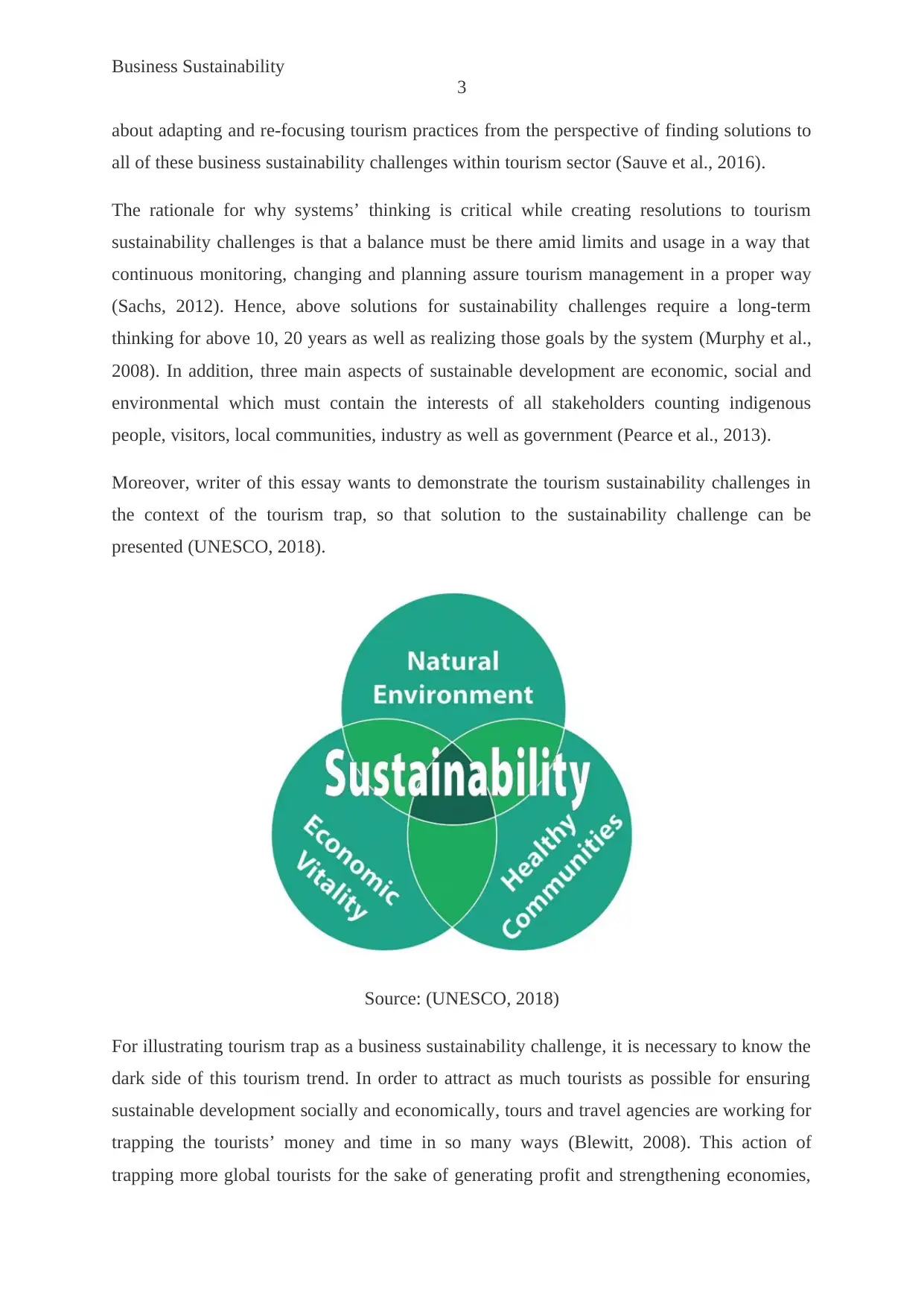
Business Sustainability
3
about adapting and re-focusing tourism practices from the perspective of finding solutions to
all of these business sustainability challenges within tourism sector (Sauve et al., 2016).
The rationale for why systems’ thinking is critical while creating resolutions to tourism
sustainability challenges is that a balance must be there amid limits and usage in a way that
continuous monitoring, changing and planning assure tourism management in a proper way
(Sachs, 2012). Hence, above solutions for sustainability challenges require a long-term
thinking for above 10, 20 years as well as realizing those goals by the system (Murphy et al.,
2008). In addition, three main aspects of sustainable development are economic, social and
environmental which must contain the interests of all stakeholders counting indigenous
people, visitors, local communities, industry as well as government (Pearce et al., 2013).
Moreover, writer of this essay wants to demonstrate the tourism sustainability challenges in
the context of the tourism trap, so that solution to the sustainability challenge can be
presented (UNESCO, 2018).
Source: (UNESCO, 2018)
For illustrating tourism trap as a business sustainability challenge, it is necessary to know the
dark side of this tourism trend. In order to attract as much tourists as possible for ensuring
sustainable development socially and economically, tours and travel agencies are working for
trapping the tourists’ money and time in so many ways (Blewitt, 2008). This action of
trapping more global tourists for the sake of generating profit and strengthening economies,
3
about adapting and re-focusing tourism practices from the perspective of finding solutions to
all of these business sustainability challenges within tourism sector (Sauve et al., 2016).
The rationale for why systems’ thinking is critical while creating resolutions to tourism
sustainability challenges is that a balance must be there amid limits and usage in a way that
continuous monitoring, changing and planning assure tourism management in a proper way
(Sachs, 2012). Hence, above solutions for sustainability challenges require a long-term
thinking for above 10, 20 years as well as realizing those goals by the system (Murphy et al.,
2008). In addition, three main aspects of sustainable development are economic, social and
environmental which must contain the interests of all stakeholders counting indigenous
people, visitors, local communities, industry as well as government (Pearce et al., 2013).
Moreover, writer of this essay wants to demonstrate the tourism sustainability challenges in
the context of the tourism trap, so that solution to the sustainability challenge can be
presented (UNESCO, 2018).
Source: (UNESCO, 2018)
For illustrating tourism trap as a business sustainability challenge, it is necessary to know the
dark side of this tourism trend. In order to attract as much tourists as possible for ensuring
sustainable development socially and economically, tours and travel agencies are working for
trapping the tourists’ money and time in so many ways (Blewitt, 2008). This action of
trapping more global tourists for the sake of generating profit and strengthening economies,
Paraphrase This Document
Need a fresh take? Get an instant paraphrase of this document with our AI Paraphraser
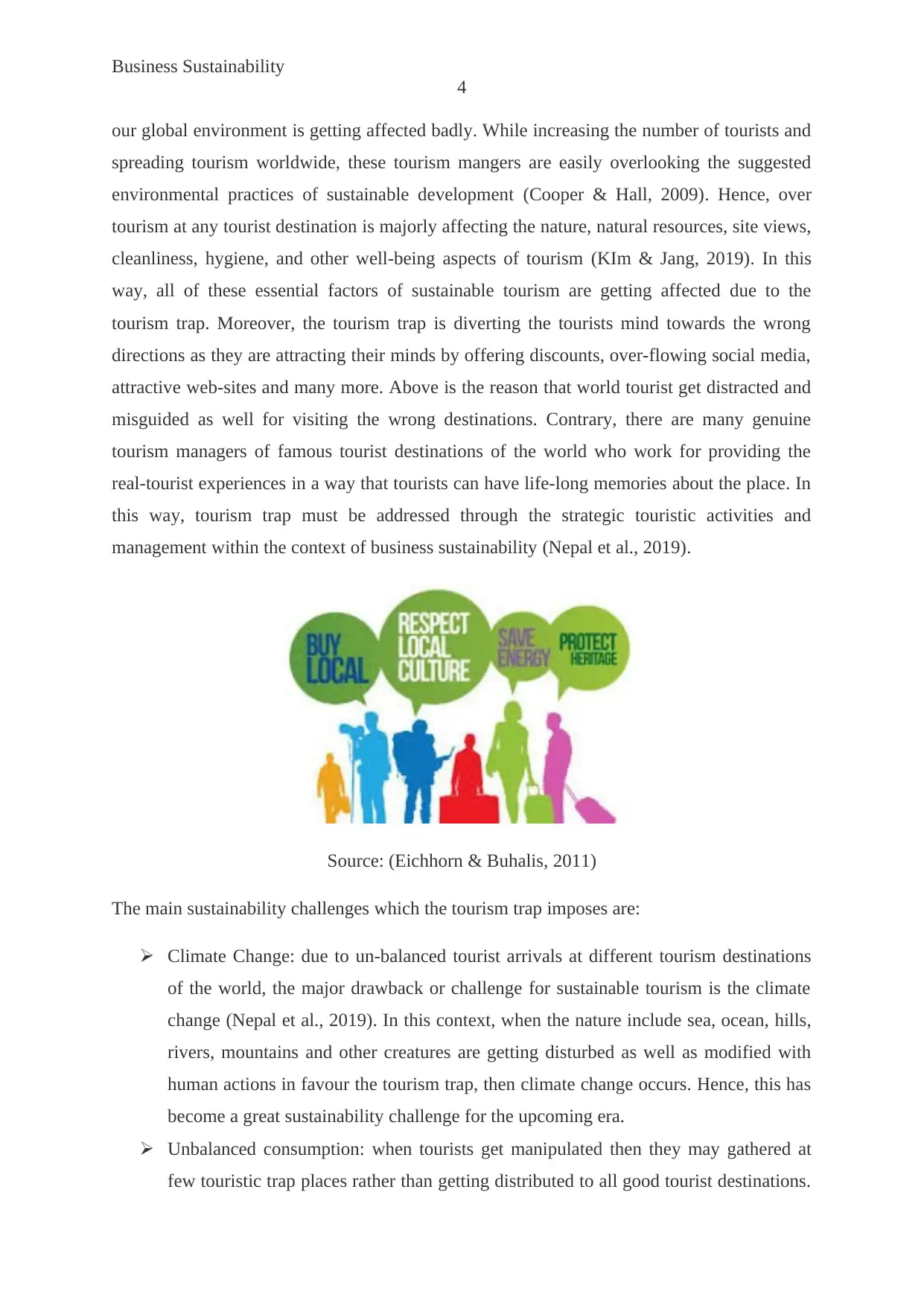
Business Sustainability
4
our global environment is getting affected badly. While increasing the number of tourists and
spreading tourism worldwide, these tourism mangers are easily overlooking the suggested
environmental practices of sustainable development (Cooper & Hall, 2009). Hence, over
tourism at any tourist destination is majorly affecting the nature, natural resources, site views,
cleanliness, hygiene, and other well-being aspects of tourism (KIm & Jang, 2019). In this
way, all of these essential factors of sustainable tourism are getting affected due to the
tourism trap. Moreover, the tourism trap is diverting the tourists mind towards the wrong
directions as they are attracting their minds by offering discounts, over-flowing social media,
attractive web-sites and many more. Above is the reason that world tourist get distracted and
misguided as well for visiting the wrong destinations. Contrary, there are many genuine
tourism managers of famous tourist destinations of the world who work for providing the
real-tourist experiences in a way that tourists can have life-long memories about the place. In
this way, tourism trap must be addressed through the strategic touristic activities and
management within the context of business sustainability (Nepal et al., 2019).
Source: (Eichhorn & Buhalis, 2011)
The main sustainability challenges which the tourism trap imposes are:
Climate Change: due to un-balanced tourist arrivals at different tourism destinations
of the world, the major drawback or challenge for sustainable tourism is the climate
change (Nepal et al., 2019). In this context, when the nature include sea, ocean, hills,
rivers, mountains and other creatures are getting disturbed as well as modified with
human actions in favour the tourism trap, then climate change occurs. Hence, this has
become a great sustainability challenge for the upcoming era.
Unbalanced consumption: when tourists get manipulated then they may gathered at
few touristic trap places rather than getting distributed to all good tourist destinations.
4
our global environment is getting affected badly. While increasing the number of tourists and
spreading tourism worldwide, these tourism mangers are easily overlooking the suggested
environmental practices of sustainable development (Cooper & Hall, 2009). Hence, over
tourism at any tourist destination is majorly affecting the nature, natural resources, site views,
cleanliness, hygiene, and other well-being aspects of tourism (KIm & Jang, 2019). In this
way, all of these essential factors of sustainable tourism are getting affected due to the
tourism trap. Moreover, the tourism trap is diverting the tourists mind towards the wrong
directions as they are attracting their minds by offering discounts, over-flowing social media,
attractive web-sites and many more. Above is the reason that world tourist get distracted and
misguided as well for visiting the wrong destinations. Contrary, there are many genuine
tourism managers of famous tourist destinations of the world who work for providing the
real-tourist experiences in a way that tourists can have life-long memories about the place. In
this way, tourism trap must be addressed through the strategic touristic activities and
management within the context of business sustainability (Nepal et al., 2019).
Source: (Eichhorn & Buhalis, 2011)
The main sustainability challenges which the tourism trap imposes are:
Climate Change: due to un-balanced tourist arrivals at different tourism destinations
of the world, the major drawback or challenge for sustainable tourism is the climate
change (Nepal et al., 2019). In this context, when the nature include sea, ocean, hills,
rivers, mountains and other creatures are getting disturbed as well as modified with
human actions in favour the tourism trap, then climate change occurs. Hence, this has
become a great sustainability challenge for the upcoming era.
Unbalanced consumption: when tourists get manipulated then they may gathered at
few touristic trap places rather than getting distributed to all good tourist destinations.
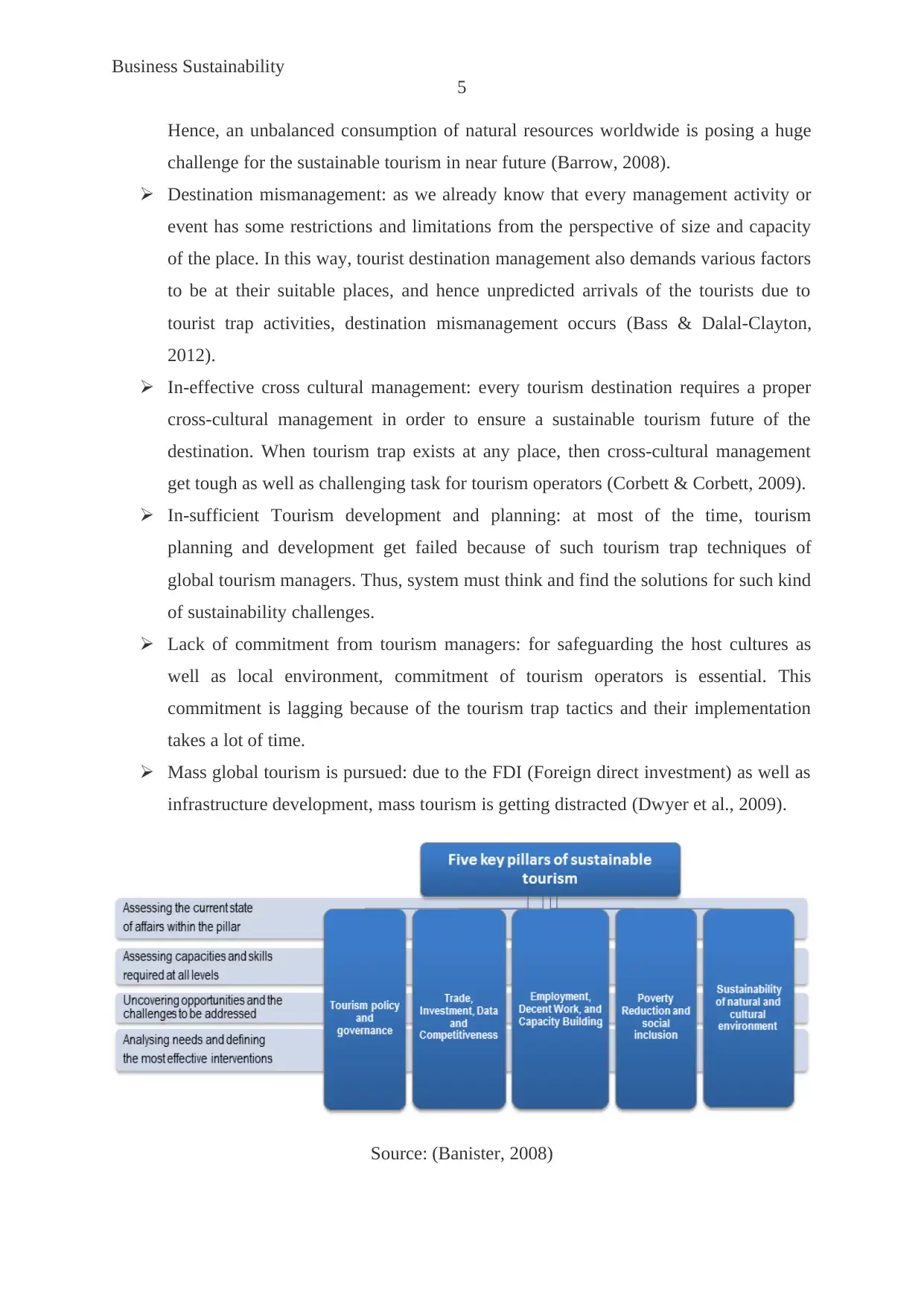
Business Sustainability
5
Hence, an unbalanced consumption of natural resources worldwide is posing a huge
challenge for the sustainable tourism in near future (Barrow, 2008).
Destination mismanagement: as we already know that every management activity or
event has some restrictions and limitations from the perspective of size and capacity
of the place. In this way, tourist destination management also demands various factors
to be at their suitable places, and hence unpredicted arrivals of the tourists due to
tourist trap activities, destination mismanagement occurs (Bass & Dalal-Clayton,
2012).
In-effective cross cultural management: every tourism destination requires a proper
cross-cultural management in order to ensure a sustainable tourism future of the
destination. When tourism trap exists at any place, then cross-cultural management
get tough as well as challenging task for tourism operators (Corbett & Corbett, 2009).
In-sufficient Tourism development and planning: at most of the time, tourism
planning and development get failed because of such tourism trap techniques of
global tourism managers. Thus, system must think and find the solutions for such kind
of sustainability challenges.
Lack of commitment from tourism managers: for safeguarding the host cultures as
well as local environment, commitment of tourism operators is essential. This
commitment is lagging because of the tourism trap tactics and their implementation
takes a lot of time.
Mass global tourism is pursued: due to the FDI (Foreign direct investment) as well as
infrastructure development, mass tourism is getting distracted (Dwyer et al., 2009).
Source: (Banister, 2008)
5
Hence, an unbalanced consumption of natural resources worldwide is posing a huge
challenge for the sustainable tourism in near future (Barrow, 2008).
Destination mismanagement: as we already know that every management activity or
event has some restrictions and limitations from the perspective of size and capacity
of the place. In this way, tourist destination management also demands various factors
to be at their suitable places, and hence unpredicted arrivals of the tourists due to
tourist trap activities, destination mismanagement occurs (Bass & Dalal-Clayton,
2012).
In-effective cross cultural management: every tourism destination requires a proper
cross-cultural management in order to ensure a sustainable tourism future of the
destination. When tourism trap exists at any place, then cross-cultural management
get tough as well as challenging task for tourism operators (Corbett & Corbett, 2009).
In-sufficient Tourism development and planning: at most of the time, tourism
planning and development get failed because of such tourism trap techniques of
global tourism managers. Thus, system must think and find the solutions for such kind
of sustainability challenges.
Lack of commitment from tourism managers: for safeguarding the host cultures as
well as local environment, commitment of tourism operators is essential. This
commitment is lagging because of the tourism trap tactics and their implementation
takes a lot of time.
Mass global tourism is pursued: due to the FDI (Foreign direct investment) as well as
infrastructure development, mass tourism is getting distracted (Dwyer et al., 2009).
Source: (Banister, 2008)
⊘ This is a preview!⊘
Do you want full access?
Subscribe today to unlock all pages.

Trusted by 1+ million students worldwide
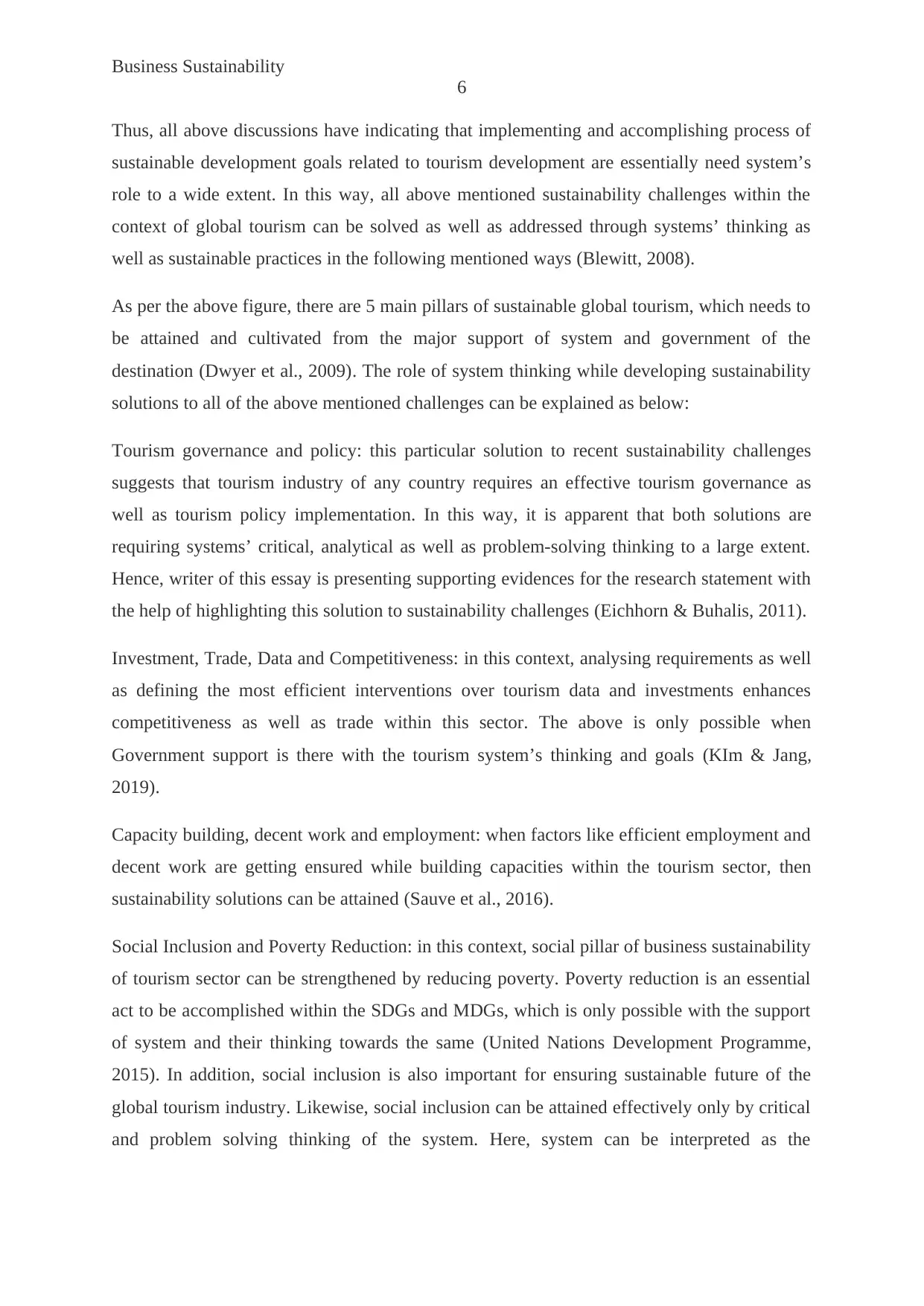
Business Sustainability
6
Thus, all above discussions have indicating that implementing and accomplishing process of
sustainable development goals related to tourism development are essentially need system’s
role to a wide extent. In this way, all above mentioned sustainability challenges within the
context of global tourism can be solved as well as addressed through systems’ thinking as
well as sustainable practices in the following mentioned ways (Blewitt, 2008).
As per the above figure, there are 5 main pillars of sustainable global tourism, which needs to
be attained and cultivated from the major support of system and government of the
destination (Dwyer et al., 2009). The role of system thinking while developing sustainability
solutions to all of the above mentioned challenges can be explained as below:
Tourism governance and policy: this particular solution to recent sustainability challenges
suggests that tourism industry of any country requires an effective tourism governance as
well as tourism policy implementation. In this way, it is apparent that both solutions are
requiring systems’ critical, analytical as well as problem-solving thinking to a large extent.
Hence, writer of this essay is presenting supporting evidences for the research statement with
the help of highlighting this solution to sustainability challenges (Eichhorn & Buhalis, 2011).
Investment, Trade, Data and Competitiveness: in this context, analysing requirements as well
as defining the most efficient interventions over tourism data and investments enhances
competitiveness as well as trade within this sector. The above is only possible when
Government support is there with the tourism system’s thinking and goals (KIm & Jang,
2019).
Capacity building, decent work and employment: when factors like efficient employment and
decent work are getting ensured while building capacities within the tourism sector, then
sustainability solutions can be attained (Sauve et al., 2016).
Social Inclusion and Poverty Reduction: in this context, social pillar of business sustainability
of tourism sector can be strengthened by reducing poverty. Poverty reduction is an essential
act to be accomplished within the SDGs and MDGs, which is only possible with the support
of system and their thinking towards the same (United Nations Development Programme,
2015). In addition, social inclusion is also important for ensuring sustainable future of the
global tourism industry. Likewise, social inclusion can be attained effectively only by critical
and problem solving thinking of the system. Here, system can be interpreted as the
6
Thus, all above discussions have indicating that implementing and accomplishing process of
sustainable development goals related to tourism development are essentially need system’s
role to a wide extent. In this way, all above mentioned sustainability challenges within the
context of global tourism can be solved as well as addressed through systems’ thinking as
well as sustainable practices in the following mentioned ways (Blewitt, 2008).
As per the above figure, there are 5 main pillars of sustainable global tourism, which needs to
be attained and cultivated from the major support of system and government of the
destination (Dwyer et al., 2009). The role of system thinking while developing sustainability
solutions to all of the above mentioned challenges can be explained as below:
Tourism governance and policy: this particular solution to recent sustainability challenges
suggests that tourism industry of any country requires an effective tourism governance as
well as tourism policy implementation. In this way, it is apparent that both solutions are
requiring systems’ critical, analytical as well as problem-solving thinking to a large extent.
Hence, writer of this essay is presenting supporting evidences for the research statement with
the help of highlighting this solution to sustainability challenges (Eichhorn & Buhalis, 2011).
Investment, Trade, Data and Competitiveness: in this context, analysing requirements as well
as defining the most efficient interventions over tourism data and investments enhances
competitiveness as well as trade within this sector. The above is only possible when
Government support is there with the tourism system’s thinking and goals (KIm & Jang,
2019).
Capacity building, decent work and employment: when factors like efficient employment and
decent work are getting ensured while building capacities within the tourism sector, then
sustainability solutions can be attained (Sauve et al., 2016).
Social Inclusion and Poverty Reduction: in this context, social pillar of business sustainability
of tourism sector can be strengthened by reducing poverty. Poverty reduction is an essential
act to be accomplished within the SDGs and MDGs, which is only possible with the support
of system and their thinking towards the same (United Nations Development Programme,
2015). In addition, social inclusion is also important for ensuring sustainable future of the
global tourism industry. Likewise, social inclusion can be attained effectively only by critical
and problem solving thinking of the system. Here, system can be interpreted as the
Paraphrase This Document
Need a fresh take? Get an instant paraphrase of this document with our AI Paraphraser
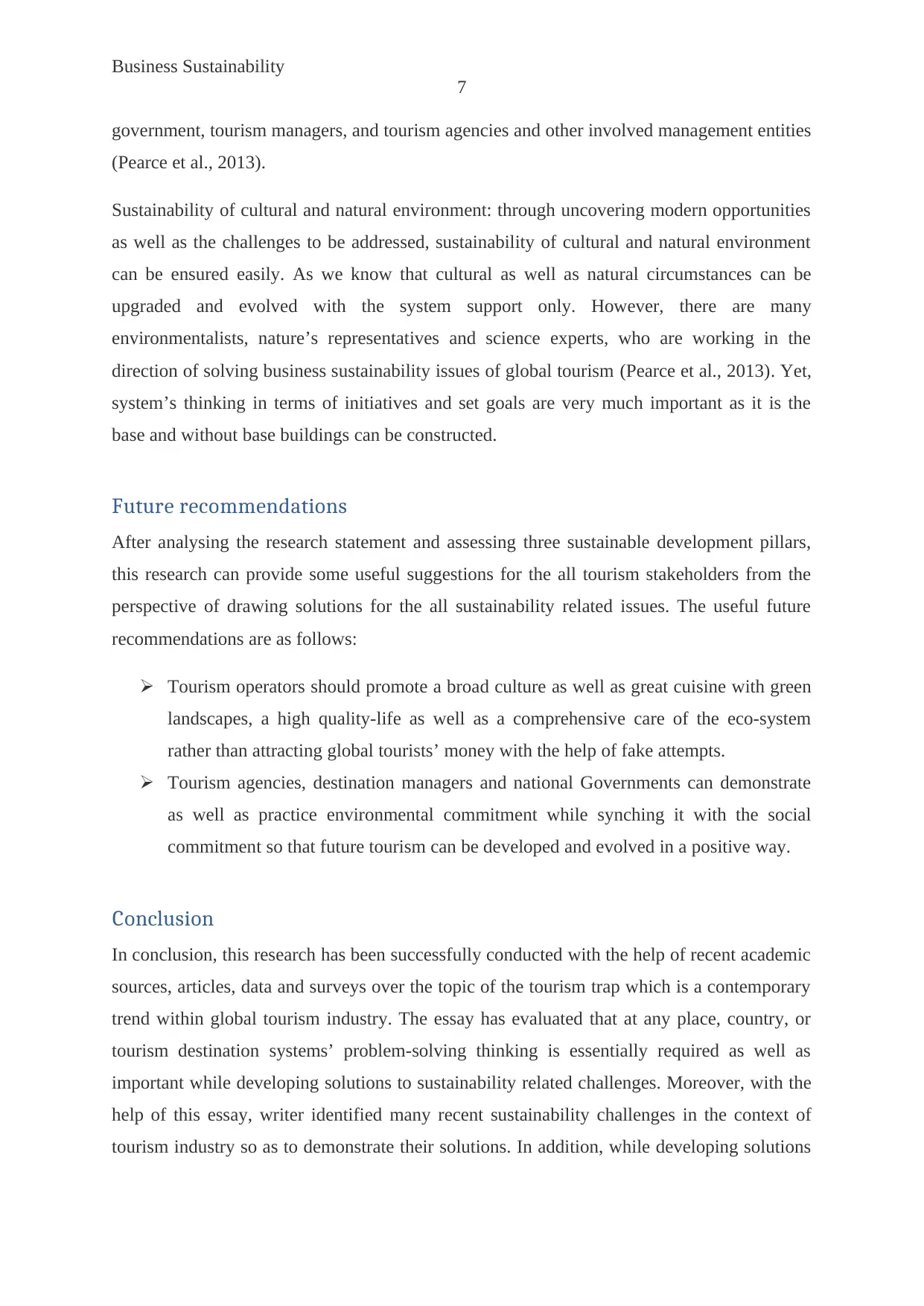
Business Sustainability
7
government, tourism managers, and tourism agencies and other involved management entities
(Pearce et al., 2013).
Sustainability of cultural and natural environment: through uncovering modern opportunities
as well as the challenges to be addressed, sustainability of cultural and natural environment
can be ensured easily. As we know that cultural as well as natural circumstances can be
upgraded and evolved with the system support only. However, there are many
environmentalists, nature’s representatives and science experts, who are working in the
direction of solving business sustainability issues of global tourism (Pearce et al., 2013). Yet,
system’s thinking in terms of initiatives and set goals are very much important as it is the
base and without base buildings can be constructed.
Future recommendations
After analysing the research statement and assessing three sustainable development pillars,
this research can provide some useful suggestions for the all tourism stakeholders from the
perspective of drawing solutions for the all sustainability related issues. The useful future
recommendations are as follows:
Tourism operators should promote a broad culture as well as great cuisine with green
landscapes, a high quality-life as well as a comprehensive care of the eco-system
rather than attracting global tourists’ money with the help of fake attempts.
Tourism agencies, destination managers and national Governments can demonstrate
as well as practice environmental commitment while synching it with the social
commitment so that future tourism can be developed and evolved in a positive way.
Conclusion
In conclusion, this research has been successfully conducted with the help of recent academic
sources, articles, data and surveys over the topic of the tourism trap which is a contemporary
trend within global tourism industry. The essay has evaluated that at any place, country, or
tourism destination systems’ problem-solving thinking is essentially required as well as
important while developing solutions to sustainability related challenges. Moreover, with the
help of this essay, writer identified many recent sustainability challenges in the context of
tourism industry so as to demonstrate their solutions. In addition, while developing solutions
7
government, tourism managers, and tourism agencies and other involved management entities
(Pearce et al., 2013).
Sustainability of cultural and natural environment: through uncovering modern opportunities
as well as the challenges to be addressed, sustainability of cultural and natural environment
can be ensured easily. As we know that cultural as well as natural circumstances can be
upgraded and evolved with the system support only. However, there are many
environmentalists, nature’s representatives and science experts, who are working in the
direction of solving business sustainability issues of global tourism (Pearce et al., 2013). Yet,
system’s thinking in terms of initiatives and set goals are very much important as it is the
base and without base buildings can be constructed.
Future recommendations
After analysing the research statement and assessing three sustainable development pillars,
this research can provide some useful suggestions for the all tourism stakeholders from the
perspective of drawing solutions for the all sustainability related issues. The useful future
recommendations are as follows:
Tourism operators should promote a broad culture as well as great cuisine with green
landscapes, a high quality-life as well as a comprehensive care of the eco-system
rather than attracting global tourists’ money with the help of fake attempts.
Tourism agencies, destination managers and national Governments can demonstrate
as well as practice environmental commitment while synching it with the social
commitment so that future tourism can be developed and evolved in a positive way.
Conclusion
In conclusion, this research has been successfully conducted with the help of recent academic
sources, articles, data and surveys over the topic of the tourism trap which is a contemporary
trend within global tourism industry. The essay has evaluated that at any place, country, or
tourism destination systems’ problem-solving thinking is essentially required as well as
important while developing solutions to sustainability related challenges. Moreover, with the
help of this essay, writer identified many recent sustainability challenges in the context of
tourism industry so as to demonstrate their solutions. In addition, while developing solutions
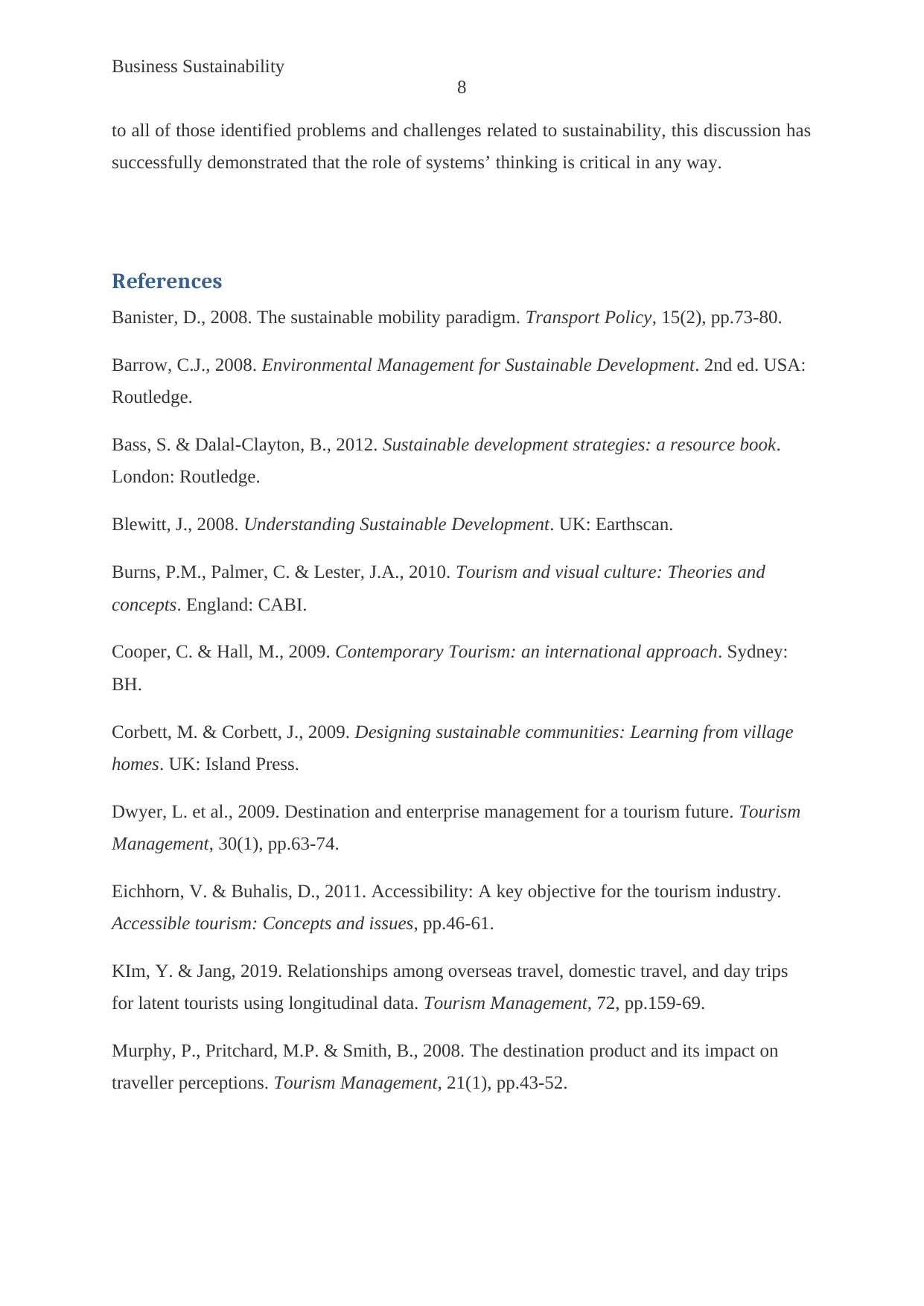
Business Sustainability
8
to all of those identified problems and challenges related to sustainability, this discussion has
successfully demonstrated that the role of systems’ thinking is critical in any way.
References
Banister, D., 2008. The sustainable mobility paradigm. Transport Policy, 15(2), pp.73-80.
Barrow, C.J., 2008. Environmental Management for Sustainable Development. 2nd ed. USA:
Routledge.
Bass, S. & Dalal-Clayton, B., 2012. Sustainable development strategies: a resource book.
London: Routledge.
Blewitt, J., 2008. Understanding Sustainable Development. UK: Earthscan.
Burns, P.M., Palmer, C. & Lester, J.A., 2010. Tourism and visual culture: Theories and
concepts. England: CABI.
Cooper, C. & Hall, M., 2009. Contemporary Tourism: an international approach. Sydney:
BH.
Corbett, M. & Corbett, J., 2009. Designing sustainable communities: Learning from village
homes. UK: Island Press.
Dwyer, L. et al., 2009. Destination and enterprise management for a tourism future. Tourism
Management, 30(1), pp.63-74.
Eichhorn, V. & Buhalis, D., 2011. Accessibility: A key objective for the tourism industry.
Accessible tourism: Concepts and issues, pp.46-61.
KIm, Y. & Jang, 2019. Relationships among overseas travel, domestic travel, and day trips
for latent tourists using longitudinal data. Tourism Management, 72, pp.159-69.
Murphy, P., Pritchard, M.P. & Smith, B., 2008. The destination product and its impact on
traveller perceptions. Tourism Management, 21(1), pp.43-52.
8
to all of those identified problems and challenges related to sustainability, this discussion has
successfully demonstrated that the role of systems’ thinking is critical in any way.
References
Banister, D., 2008. The sustainable mobility paradigm. Transport Policy, 15(2), pp.73-80.
Barrow, C.J., 2008. Environmental Management for Sustainable Development. 2nd ed. USA:
Routledge.
Bass, S. & Dalal-Clayton, B., 2012. Sustainable development strategies: a resource book.
London: Routledge.
Blewitt, J., 2008. Understanding Sustainable Development. UK: Earthscan.
Burns, P.M., Palmer, C. & Lester, J.A., 2010. Tourism and visual culture: Theories and
concepts. England: CABI.
Cooper, C. & Hall, M., 2009. Contemporary Tourism: an international approach. Sydney:
BH.
Corbett, M. & Corbett, J., 2009. Designing sustainable communities: Learning from village
homes. UK: Island Press.
Dwyer, L. et al., 2009. Destination and enterprise management for a tourism future. Tourism
Management, 30(1), pp.63-74.
Eichhorn, V. & Buhalis, D., 2011. Accessibility: A key objective for the tourism industry.
Accessible tourism: Concepts and issues, pp.46-61.
KIm, Y. & Jang, 2019. Relationships among overseas travel, domestic travel, and day trips
for latent tourists using longitudinal data. Tourism Management, 72, pp.159-69.
Murphy, P., Pritchard, M.P. & Smith, B., 2008. The destination product and its impact on
traveller perceptions. Tourism Management, 21(1), pp.43-52.
⊘ This is a preview!⊘
Do you want full access?
Subscribe today to unlock all pages.

Trusted by 1+ million students worldwide
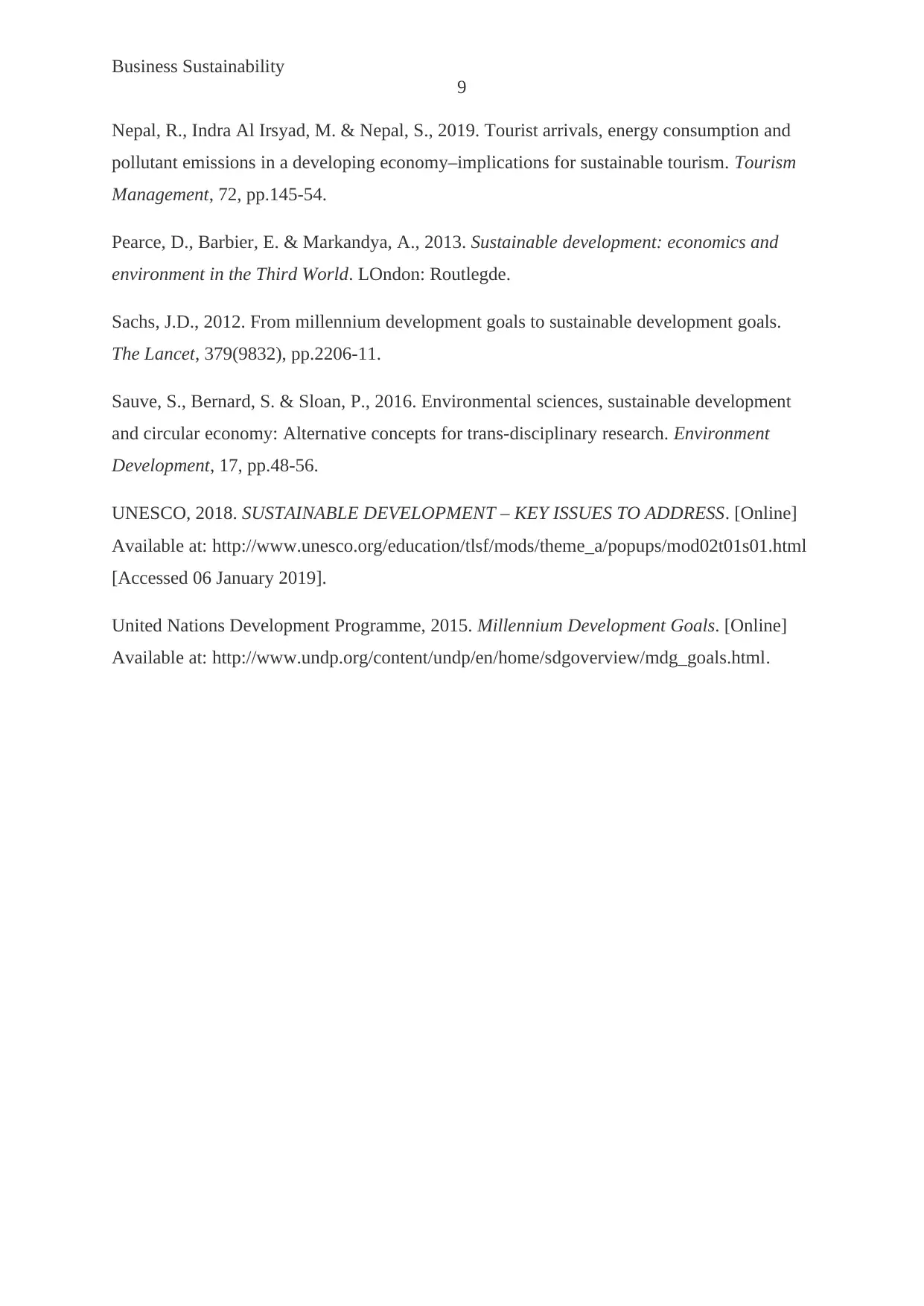
Business Sustainability
9
Nepal, R., Indra Al Irsyad, M. & Nepal, S., 2019. Tourist arrivals, energy consumption and
pollutant emissions in a developing economy–implications for sustainable tourism. Tourism
Management, 72, pp.145-54.
Pearce, D., Barbier, E. & Markandya, A., 2013. Sustainable development: economics and
environment in the Third World. LOndon: Routlegde.
Sachs, J.D., 2012. From millennium development goals to sustainable development goals.
The Lancet, 379(9832), pp.2206-11.
Sauve, S., Bernard, S. & Sloan, P., 2016. Environmental sciences, sustainable development
and circular economy: Alternative concepts for trans-disciplinary research. Environment
Development, 17, pp.48-56.
UNESCO, 2018. SUSTAINABLE DEVELOPMENT – KEY ISSUES TO ADDRESS. [Online]
Available at: http://www.unesco.org/education/tlsf/mods/theme_a/popups/mod02t01s01.html
[Accessed 06 January 2019].
United Nations Development Programme, 2015. Millennium Development Goals. [Online]
Available at: http://www.undp.org/content/undp/en/home/sdgoverview/mdg_goals.html.
9
Nepal, R., Indra Al Irsyad, M. & Nepal, S., 2019. Tourist arrivals, energy consumption and
pollutant emissions in a developing economy–implications for sustainable tourism. Tourism
Management, 72, pp.145-54.
Pearce, D., Barbier, E. & Markandya, A., 2013. Sustainable development: economics and
environment in the Third World. LOndon: Routlegde.
Sachs, J.D., 2012. From millennium development goals to sustainable development goals.
The Lancet, 379(9832), pp.2206-11.
Sauve, S., Bernard, S. & Sloan, P., 2016. Environmental sciences, sustainable development
and circular economy: Alternative concepts for trans-disciplinary research. Environment
Development, 17, pp.48-56.
UNESCO, 2018. SUSTAINABLE DEVELOPMENT – KEY ISSUES TO ADDRESS. [Online]
Available at: http://www.unesco.org/education/tlsf/mods/theme_a/popups/mod02t01s01.html
[Accessed 06 January 2019].
United Nations Development Programme, 2015. Millennium Development Goals. [Online]
Available at: http://www.undp.org/content/undp/en/home/sdgoverview/mdg_goals.html.
1 out of 10
Related Documents
Your All-in-One AI-Powered Toolkit for Academic Success.
+13062052269
info@desklib.com
Available 24*7 on WhatsApp / Email
![[object Object]](/_next/static/media/star-bottom.7253800d.svg)
Unlock your academic potential
Copyright © 2020–2025 A2Z Services. All Rights Reserved. Developed and managed by ZUCOL.




